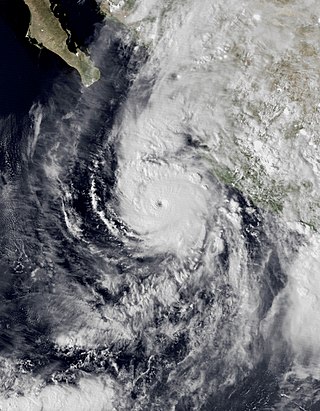
Nayarit, officially the Estado Libre y Soberano de Nayarit, is one of the 31 states that, along with Mexico City, comprise the Federal Entities of Mexico. It is divided in 20 municipalities and its capital city is Tepic.

Alí Chumacero Lora was a Mexican poet, translator, literary critic and editor. He was a member of the Mexican Academy of Language.
El Nayar is a municipality in the Mexican state of Nayarit. The population was 30,551 in 2005 in a total area of 5,100 km². The municipal seat of Jesús María had a population of 1,520 in 2005. El Nayar is the home of the Huichol, Cora, and the Tepehuán Indians.

Federal Highway 15 is Mexico 15 International Highway or Mexico-Nogales Highway, is a primary north–south highway, and is a free part of the federal highways corridors of Mexico. The highway begins in the north at the Mexico–United States border at the Nogales Port of Entry in Nogales, Sonora, and terminates to the south in Mexico City.

José María Narváez was a Spanish naval officer, explorer, and navigator notable for his work in the Gulf Islands and Lower Mainland of present-day British Columbia. In 1791, as commander of the schooner Santa Saturnina, he led the first European exploration of the Strait of Georgia, including a landing on present-day British Columbia's Sunshine Coast. He also entered Burrard Inlet, the site of present-day Vancouver, British Columbia.

Ixtlán del Río is both a municipality and the municipal seat in the Mexican state of Nayarit. In 2018, the population of the municipality was 33,289, with 35,180 residents living in the municipal seat. The total area of the municipality is 581.4 km².

Sandra Ávila Beltrán is a Mexican drug lord, dubbed "La Reina del Pacífico" by the media. She was arrested on September 28, 2007, and was charged with organized crime and conspiracy to drug trafficking. Some charges were later dropped but she was still held on possession of illegal weapons and money laundering, pending her extradition to the United States. On August 10, 2012, she was extradited to the United States to answer to criminal charges by the U.S. government.
The First Federal Electoral District of Nayarit(I Distrito Electoral Federal de Nayarit) is one of the 300 Electoral Districts into which Mexico is divided for the purpose of elections to the federal Chamber of Deputies and one of three such districts in the state of Nayarit.

Roxana del Consuelo Sáizar Guerrero, is an editor and publisher, former CEO of Fondo de Cultura Económica (2002-2009), President of the National Council for Culture and the Arts (CONACULTA) (2009-2012) and President of the Regional Center for the Promotion of Books in Latin America and the Caribbean (Cerlalc) (2010-2012). She began her career working in the family printing business at her home state of Nayarit. After graduating with a degree in Communications in 1983, she began to manage editorial departments and publishing houses until 2002, when she was appointed director of government-owned Fondo de Cultura Económica, which is considered the largest publishing house in Latin America. She restructured the organization and started its electronic publishing program. In 2009, she was named President of CONACULTA, an institution devoted to promoting Mexican culture both domestically and abroad, that has since been transformed into the National Ministry of Culture.
This is a list of events that happened in 2008 in Mexico.

Manuel Lozada, nicknamed "The Tiger of Álica", was a regional caudillo based in the region of Tepic, Mexico. He was born in 1828 in the Tepic Territory, Mexico and died on July 19, 1873, in Loma de los Metates, Nayarit.

General Juan Carrasco (1878–1922) was a Mexican rancher and military officer who participated in the Mexican Revolution. He was Chief of Military Operations of Baja California, Sonora, Sinaloa, and Nayarit.

El FUA is an Internet meme involving a viral YouTube video of an intoxicated Mexican man called Julio César Segura, who claims to have divine powers, including fortune-telling and revival of the dead.
The following lists events that happened during 2000 in Mexico.

Emilia Ortiz Pérez was a Nayarit Mexican painter, cartoonist, caricaturist, and poet, best known for her watercolors she made of the indigenous groups in her area, and the caricatures she created from an early age of political figures and those she knew. Emilia would go on to create over 4,000 works that varied in subject matter. Her father, Abraham D. Ortiz, had arrived at Tepic originally from Oaxaca where he married Elvira Perez and engaged in haberdashery and the hardware trade. Emilia studied painting at the Academy of San Carlos in Mexico City. Her drawings and paintings were exhibited in 1940. An author as well, her prizewinning book, De mis soledades vengo, was published in 1986. The Museo Emilia Ortiz in Lerdo houses Ortiz's photography and art, as well as local art. She is survived by her daughter Gabriela, who is the current curator of the Contemporary Art Center Emilia Ortiz.
Federal Highway 15D is the name for toll highways paralleling Federal Highway 15. The toll segments of Highway 15D include some of the most significant highways in the country along the Nogales-Mexico City corridor. The highway is the southern terminus of the CANAMEX Corridor, a trade corridor that stretches from Mexico north across the United States to the Canadian province of Alberta.

Hurricane Willa was a powerful tropical cyclone that brought torrential rains and destructive winds to southwestern Mexico, particularly the states of Sinaloa and Nayarit, during late October 2018. It was the twenty-fifth tropical cyclone, twenty-second named storm, thirteenth hurricane, tenth major hurricane, and record-tying third Category 5 hurricane of the 2018 Pacific hurricane season. Willa was the first major hurricane to make landfall in the Mexican state of Sinaloa since Lane in 2006.

Acatlán Fútbol Club is a Mexican football club that plays in the Third Division. It is based in the city of Zapotlanejo.

Hurricane Pamela was a Category 1 Pacific hurricane that caused seven deaths and US$10 million in damage across the northwestern and western states of Mexico in October 2021. The sixteenth named storm and seventh hurricane of the 2021 Pacific hurricane season, the storm originated from a tropical wave over the Atlantic basin, over the Caribbean Sea. It then quickly crossed into the Pacific Ocean, where it slowly consolidated, with a low-pressure area forming from the wave on October 9. Environmental conditions in the area were proved favorable for tropical cyclogenesis and developed into Tropical Depression Sixteen-E on the next day. It then organized further into Tropical Storm Pamela on that night. Despite wind shear and dry air affecting the cyclone, Pamela continued to strengthen and became a hurricane on October 12 before weakening back to a tropical storm as it continued to succumb onto these factors. However, as the system turned towards the coast of Mexico, Pamela restrengthened to a low-end hurricane before making landfall over Estacion Dimas, Sinaloa on 15:00 UTC on October 13 before rapidly weakening inland. It then dissipated over Coahuila on the early hours on the next day.
The Battle of Cuernavaca was a battle during the Mexican Revolution, where Emiliano Zapata and his supporters rebelling against president Francisco I. Madero, who had recently overthrown the previous president Porfirio Díaz. Zapata was patrolling around his stronghold in the hills of Cuernavaca, where he was ambushed by a government force of Rurales under the command of the American Soldier of Fortune, Emil Lewis Holmdahl.















